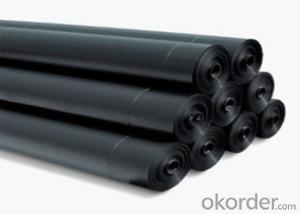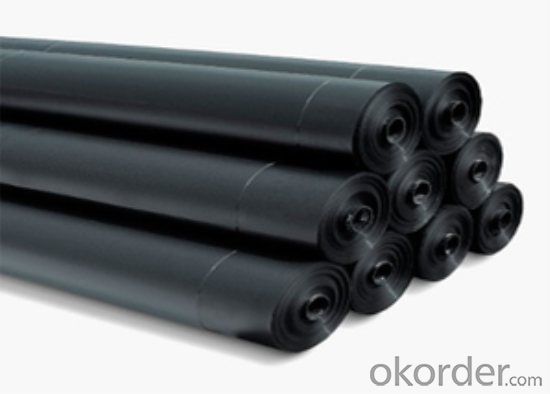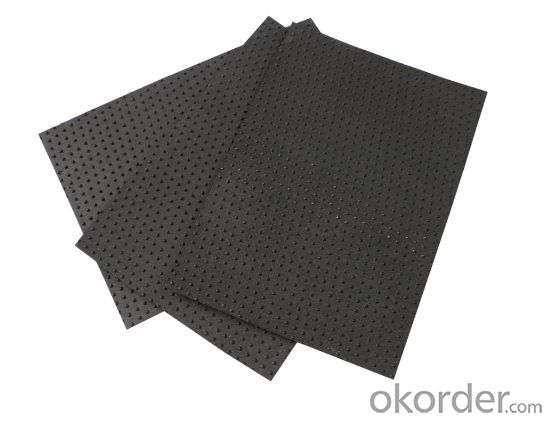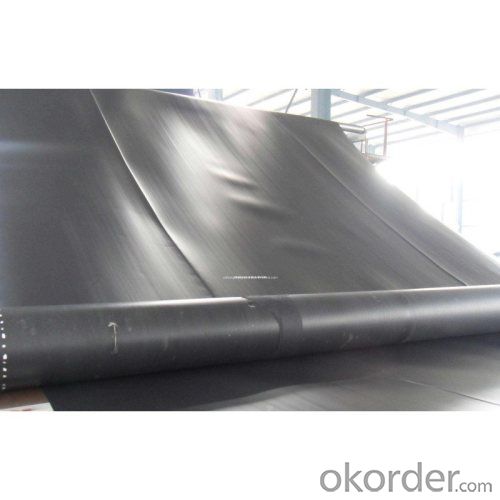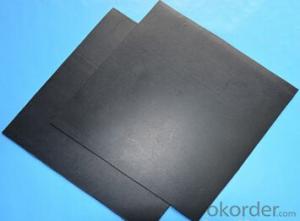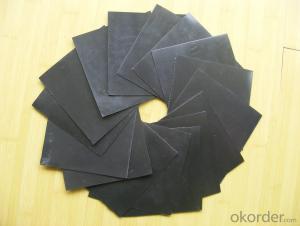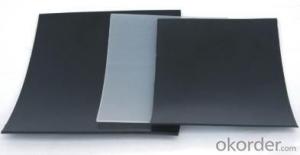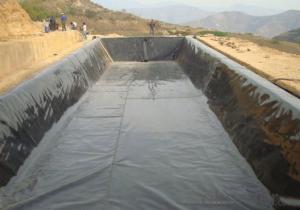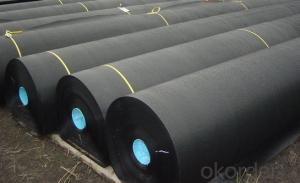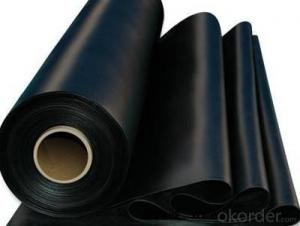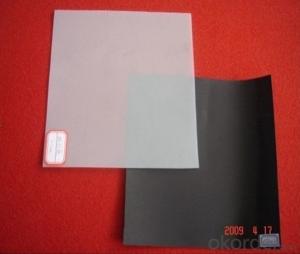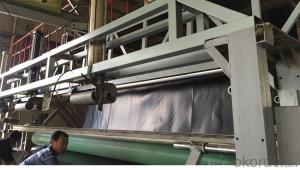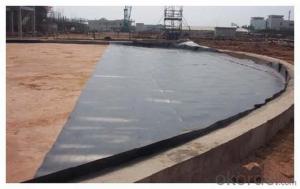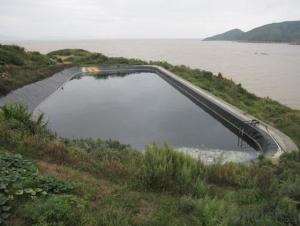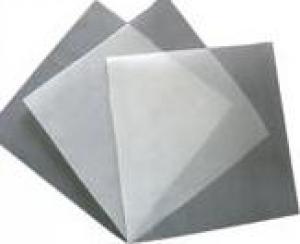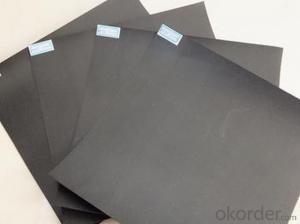Geomembrana Para Techos LLDPE 1.2mm para Ingeniería Arquitectónica
- Loading Port:
- Qingdao
- Payment Terms:
- TT or LC
- Min Order Qty:
- 3000 m²
- Supply Capability:
- 100000 m²/month
OKorder Service Pledge
OKorder Financial Service
You Might Also Like
Geomembrane LLDPE for Architectural Engineering
Description Of Geomembrane LLDPE for Architectural Engineering
Geomembrane, water-proof plate, is made from polymer materials like polyethylene, through blow molding.
Main Features of Geomembrane LLDPE for Architectural Engineering
molecular structure, Polyethylene (PE) geomembrane is divided into low-density polyethylene (LDPE) geomembrane, linear low density polyethylene (LLDPE) geomembrane, high-density polyethylene (HDPE) geomembrane;Aside from colorless and transparent raw material, you can made it into the black, green, blue, yellow, etc by adding different color masterbatch., also made into geomembrane with the black front and the blue back or other 2 different colors as required by customers.
Applications of GeomembraneLLDPE for Architectural Engineering
1.LDPE geomembrane is applicable to environmental protection and sanitation: such as landfill, sewage treatment plant, power plant adjustive pool, industrial, hospital solid waste;
2.LDPE geomembrane is applicable to hydraulic engineering: such as seepage control, plugging, reinforcement for rivers, lakes and reservoirs and dams, drainage seepage control, vertical core wall, slope protection, etc.
3. LDPE geomembrane's applications in municipal engineering: subway, underground works of the building, planting roof, roof garden, sewage pipe seepage control;
4. Polyethylene impermeable membrane is applicable to the garden: artificial lake, river, reservoir, golf course pond bottom, slope, green lawn waterproofing and damp-proofing;
5. High density polyethylene geomembrane is applicable to petrochemical industry: chemical plant, oil refinery, storage tank seepage control, chemical reaction cell, lining and secondary lining for sedimentation tank, etc.
6. Polyethylene geomembrane is applicable to mining: washing pool, soaking pool, the ash-field, dissolving pool, settling pool, yard, tailings substrates seepage control;
7. Low density polyethylene geomembrane for transport facilities: foundation reinforcement for the road, culvert seepage control;
IMages of GeomembraneLLDPE for Architectural Engineering
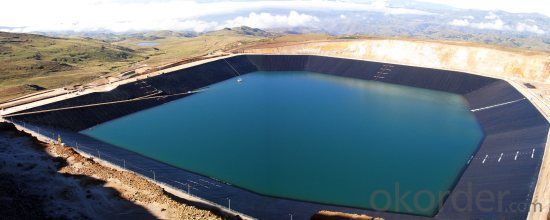
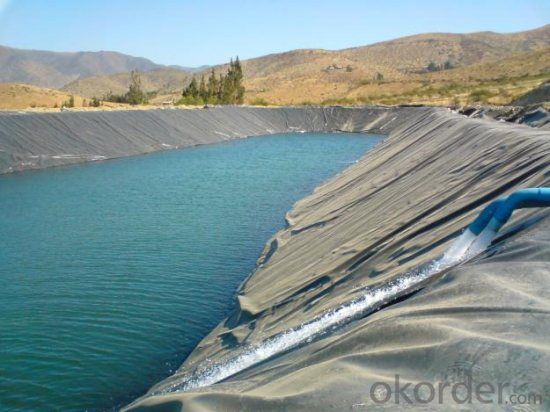
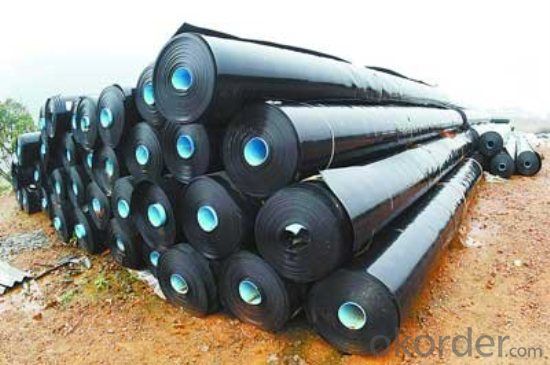


FAQ:
1. What are we supplying?
We are specialized in producing .geotextile , geogrid, geomembrane
2. How Many years experience do we have?
We have been exported to more than 15 countries in the past 10 years.
3. How long do we usually reply your request?
We always reply our customer within 12 hours.
- Q: Are geomembranes suitable for use in reservoirs?
- Yes, geomembranes are suitable for use in reservoirs. They are often used as liners or covers in reservoirs to prevent seepage and contamination, ensuring the integrity and durability of the reservoir structure. Geomembranes offer excellent impermeability, chemical resistance, and long-term performance, making them an effective solution for maintaining water quality and minimizing water loss in reservoirs.
- Q: What's the technical standards of geomembrane?
- The national standards of geomembrane is GB / T17642-2008. Geomembrane 1. longitudinal and transverse breaking strength. 2. Vertical and horizontal elongation corresponding to the standard strength. 3. CBR bursting strength 4. 5 vertical and horizontal tearing strength. 5, hydrostatic pressure resistance. 6. peel strength. 7. vertical penetration index. 8, width deviation, the above technical requirements that confirm to the national standard are national standard geomembrane.
- Q: What are the design considerations for geomembranes?
- Some design considerations for geomembranes include the type of material used, thickness, strength, flexibility, chemical resistance, installation method, and expected lifespan. Other factors to consider are the site conditions, such as slope stability, temperature variations, and exposure to UV radiation. Additionally, the design should accommodate factors like water drainage, gas venting, and potential stressors like punctures or tears. Overall, the design should meet the specific requirements of the project, whether it is for containment, environmental protection, or erosion control.
- Q: What are the benefits of using geomembranes in waste containment?
- Geomembranes offer several benefits in waste containment. Firstly, they provide an impermeable barrier that prevents the leaching of harmful substances into the surrounding environment, protecting soil and groundwater from contamination. Secondly, geomembranes are highly resistant to chemical, biological, and physical degradation, ensuring long-term durability and effectiveness in containing waste. Additionally, they are flexible and can conform to uneven surfaces, facilitating easy installation and reducing the risk of leaks or breaches. Geomembranes also offer cost advantages, as they require minimal maintenance and can be used in a variety of waste containment applications. Overall, the use of geomembranes in waste containment provides a reliable and environmentally-friendly solution for managing and preventing the spread of hazardous waste.
- Q: What are the requirements for geomembranes used in heap leach pads?
- The requirements for geomembranes used in heap leach pads typically include high chemical resistance, durability, flexibility, and impermeability to prevent the leakage of leachate. They should also have excellent UV resistance, puncture resistance, and mechanical stability to withstand the weight of the heap and any potential settlement. Additionally, geomembranes used in heap leach pads should be compatible with the surrounding soil and have low permeability to ensure effective containment of the leaching process.
- Q: How to use the mobile phone laminator?
- The mobile phone is fixed on the mobile phone slot, and then switch the torque on the back to lift the height to the mobile phone screen. The method of application of mobile phone laminator read 2 take out the fixed SMD, one side is attached on the mebrane number 2, the mebrane is aligned at the back of screen mobile phone, and then the other side of the fixed SMD is pasted on the lifting platform. The operation method 3 of mobile phone laminator open the mebrane and clean the mobile phone screen, uncover the number 1 label of the mebrane, and press slowly the mebrane by the roller. Method 4 of using mobile phone laminator tear off the number 2 film, wipe the screen of the mobile phone with a clean cloth, which can squeeze out the rest of the bubble. Sticking the film is finished. The notice of the method of using mobile phone laminator It must clean the screen mobile phone before sticking the film.
- Q: How to judge the quality of geomembrane?
- If there is no professional testing equipment, the following ways of identification can be used, can resist most of the plant roots. 3: 1, has excellent anti-puncture ability. Good geomembrane elongation 4, decomposition resistance capacity, and then draw back with efforts. Bad one has no lustre, glossy, cut 5 cm wide strips on geomembrane, can be barely used. visual inspection. Good geomembrane is black and bright, bad geomembrane is easy to crack. Repeatedly rub, tensile testing, the materials service life is up to 30-70 years, anti ultraviolet. 2. Good geomembrane will not crack if repeatedly rubbed, good geomembrane has excellent anti-aging property. 5 times will not break
- Q: Geomembrane and geotextile construction scheme
- Shallow water lotus root planting technology has become the most water and fertilizer saving method after a few years of development. In order to break through the restricting bottleneck, cropping pattern with the best economic benefits, the most convenient management. Especially suitable for water-deficient area!
- Q: What is the mechanism of homogeneous membrane pressure transmitter?
- it is the most commonly used sensor in industrial applications, and it is widely used in water conservancy and hydroelectric power, railway transportation, intelligent buildings, production automation, aerospace, military project, petrochemical, oil well, electric power, shipbuilding, machine tools, plumbing and other industries. the mechanism is: Medium pressure is directly acted on the sensitive diaphragm and distribution on the resistance of the sensing membrane composition of Wheatstone bridge, using piezoresistive effect of the amount of pressure conversion to electrical signals, through the electronic circuit of sensitive element of millivolt signal amplification for industrial standard signal.
- Q: How to install soft membrane ceiling in conference room?
- Step 1 of soft membrane ceiling installation in conference room: 1. In accordance with the requirements of design drawings, fix a circle of supporting keel (batten or steel pipe) around the place to install soft membrane ceiling. (See construction design drawing).Note: in some large places, you need to install by block to achieve good results. In this case, you need to add batten in between. This depends on actual situation. 2. When all required battens are fixed, install and fix aluminium?alloykeel of soft membrane ceiling in the bottom of supporting keel. (See construction design drawing) Step two: 1. When all installation of aluminum keels of soft membrane ceiling are fixed, install soft membrane. First open soft membrane and heat sufficiently and evenly with dedicated heater, then insert the soft membrane into aluminium alloy keel with dedicated slotting tool, and finally cut the surrounding spare soft membrane. (See detailed construction design) 2. After installation, use a clean towel to clean soft film smallpox.
Send your message to us
Geomembrana Para Techos LLDPE 1.2mm para Ingeniería Arquitectónica
- Loading Port:
- Qingdao
- Payment Terms:
- TT or LC
- Min Order Qty:
- 3000 m²
- Supply Capability:
- 100000 m²/month
OKorder Service Pledge
OKorder Financial Service
Similar products
Hot products
Hot Searches
Related keywords
